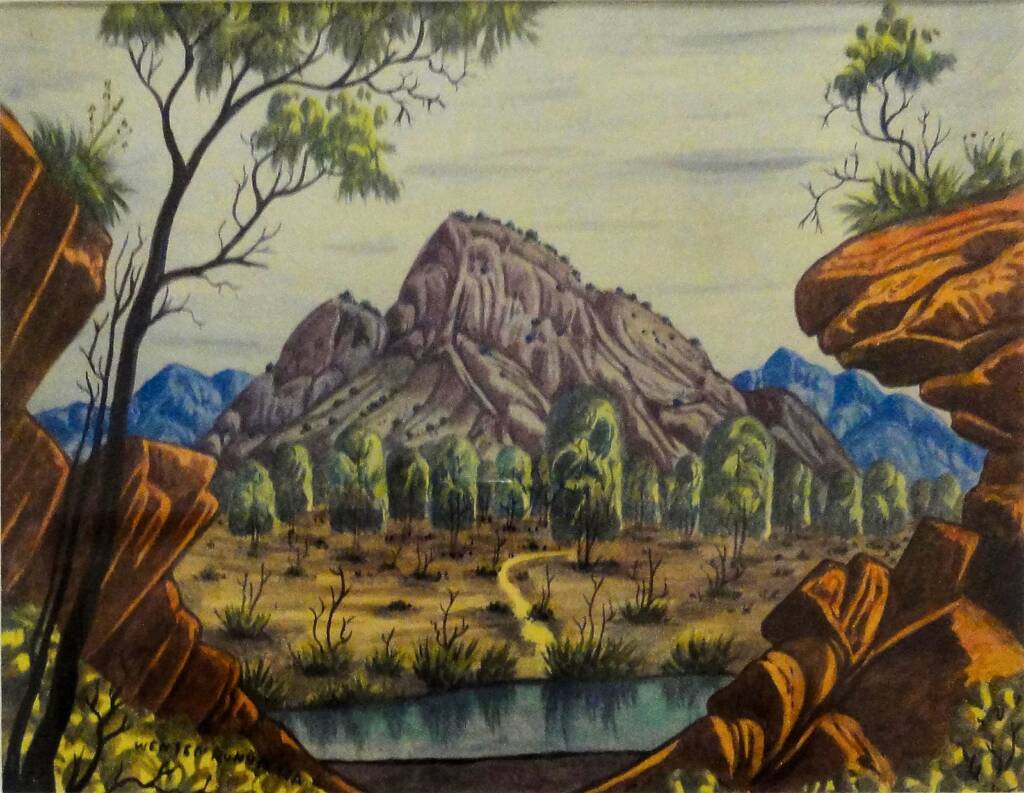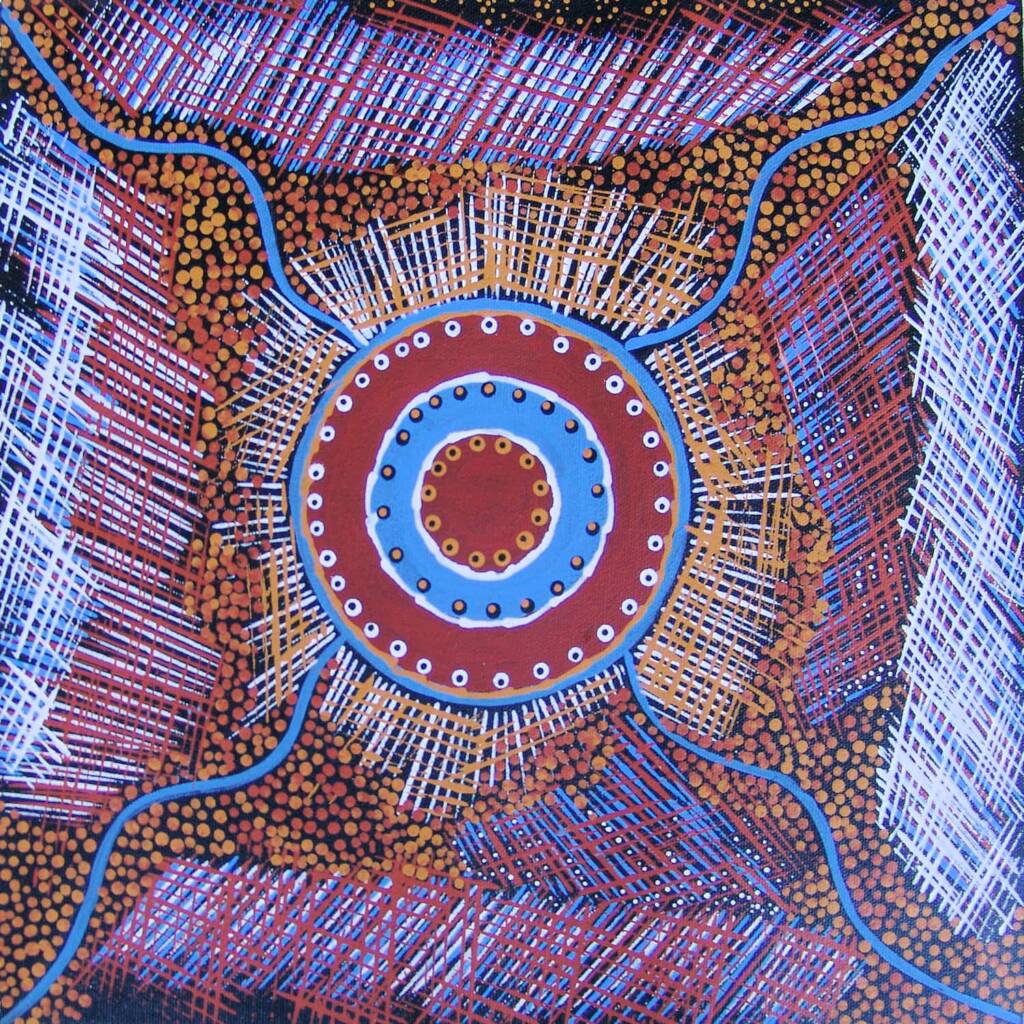Aboriginal Symbols of Country
| WARNING: Aboriginal and Torres Strait Islander people are warned that this website contain images, voices and names of people who have passed away. |
Indigenous Symbols, Iconography and Imagery
- Aboriginal Symbols
———————————— - Man Woman Child
- Human Activity
- Tools & Weapons
———————————— - Bush Food
- Bush Medicine
- Wildlife
———————————— - Landscape & Country
- Rain & Water
————————————
The depiction of landscape and country by Aboriginal artists differ markedly to those in western art. As understood and accepted, Indigenous people retained a conceptual map of country, an aerial view of the landscape looking down from above. It is a knowledge that is maintained and passed on through generations in songs and ceremony. Meshed with dreaming stories, the Aboriginal artists have a unlimited resource to draw on when recreating their Country on canvas.
There is a two layer process of being able to point out actual physical terrain in their paintings, overlaid with what we would understand as a metaphysical layer, that relates to ceremony, story, dreaming. The third layer is considered by some the obfuscation of what is being shown, although far from being unclear, the whole works makes senses to the viewer and also to those who bear the right to the dreaming.
In the following work by internationally acclaimed Dorothy Napangardi, she paints the sandhills stretching across her country of Mina Mina. An actual place, this is a major women’s ceremonial site, Dorothy’s custodial country, that is located near Lake Mackay in the Tanami Desert, north of Yuendumu in the Northern Territory.

Aboriginal artists often paint about their ‘Country’ and whilst some are in the abstract dot-style other artist choose to paint in a different style, such as the landscape paintings done by the indigenous landscape and watercolour artists of The Hermannsburg School in Central Australia.
One of the most famous artists to come out of this school of art is Albert Namatjira, who gained recognition during the 1940s and 1950s with his beautifully painted watercolours of the central desert region. His works provided a benchmark that other Aboriginal artists who painted in the same style, aspired to. His extended family continue to paint in the Hermannsburg watercolour tradition to this day.
The following work is by Aboriginal artist Bevan Young, who is a member of the extended Namitjira family, having been taught by them. Young paints in memory of Albert Namitjira, who he refers to as “Grandfather”.

Wenten Rubuntja, well known artist and Aboriginal rights activist, painted both Hermannsburg landscapes and paintings using traditional designs. Related to Albert Namatjira (Albert was his father’s cousin), who with their fathers shared the country around Palm Valley, known as Ilyape, a Honey Ant Dreaming site. Namatjira who called himself Wenten’s uncle, taught Wenten to paint. For Wenten, both the “Aranda Watercolour” style of art developed by Albert Namatjira (which has become known as the Hermannsburg School), and the “dot paintings” popularised by the artists of Papunya (Papunya Tula) reflected traditional values and themes, despite differences in technique:

“Doesn’t matter what sort of painting we do in this country, it still belongs to the people, all the people. This is worship, work, culture. It’s all Dreaming. There are two ways of painting. Both ways are important, because that’s culture.”
– The Weekend Australian Magazine, April, 2002
For those interested in learning more about the man, his autobiography – ‘The Town Grew Up Dancing’ is a fascinating and innovative book that weaves together autobiography and biography in a powerful story of recent Indigenous history in Australia. The book features Wenten’s own commentary on his paintings, and photographs in colour and black and white bring his story and Alice Springs’ colourful past vividly to life.2
Source: Gallery Gondwana
In this work by Selma Coulthard, she paints a location called Lake Eyre and the surrounding arid desert region. The symbolism of the blue lines referencing the rivers as they flow into the lake. The desert tones in the surrounding dotting and the cross hatching of whites, reds and blue to symbolise the salt encrustation that form around and in the lake.

This acrylic on board work is by Billy Benn. It is a depiction from memory of his country Artetyerre, Harts Range.
‘My country is Artetyerre, Harts Range, south and east Arrernte. My country painting. My country is Dreaming Antenhe (possum). My Dreaming corroborree. My Dreaming goes to Alcunpa, to another people’s country, north-east from Utopia.’
— Billy Benn Perrurle. Source: Museum and Art Gallery of the Northern Territory

In the following painting “Tjindara” by Linda Syddick, she paints the parallel lines being the rows and rows of high sandhills, over which Linda had walked in 1945, to reach Haasts Bluff Misson in the East.
The Spirit image is the image on the wall of a rock cave at Tjindara. This place is in the Great Sandy Desert, deep into Western Australia from Lake MacKay on the WA – NT border. The image is of a spirit, seen by someone and painted on the wall, using bright red ochre. It is bright red and shiny, due to the leaching of silicone from the rock face. This fact has enabled scientist to estimate the age of the painting to be about 15,000 years. The symbol is not an Aboriginal one, so the painting was done by a person from somewhere else, some other country, and not from Australia. This question is similar to the one scientist are working on, with the alien Bradshaw paintings in the Top End, which are 17,000 years old.
Source: Gallery Gondwana

To see, to feel, to understand is part of the journey across the landscape of country…
So in just this handful of works, we can see the vastness of styles and interpretation of the landscape and country. Some paintings have recognisable symbolism, others appear pictorial, yet all would have a deeper meaning imparted by the artists.
Footnote & References
- Sandhills of Mina Mina, 2003 © Dorothy Napangardi; Courtesy of Gallery Gondwana
- The Town Grew Up Dancing: The Life and Art of Wenten Rubuntja by Wenten Reubuntja and Jenny Green, IAD Press, Mparntwe (Alice Springs), 2002
- Gallery Gondwana, www.gallerygondwana.com.au
- Untitled Landscape of Central Australia (at top of page) © Bevan Young, Aboriginal artist from Docker River, NT.
